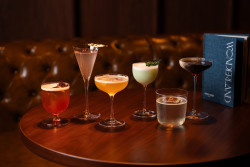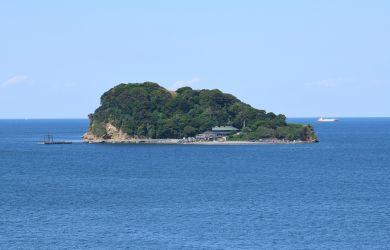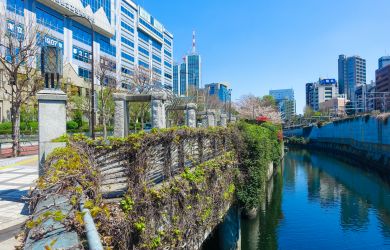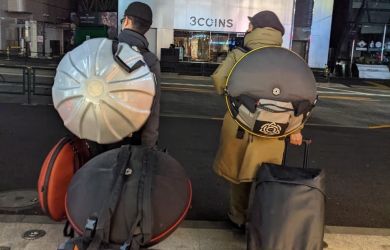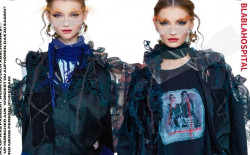
February 15, 2012
Yokoso Kyogen
Manzo Nomura and Thane Camus bring “mad words” to the barbarians
By Metropolis
Originally published on metropolis.co.jp on February 2012

When Manzo Nomura first joined his legendary father onstage as a small boy, to perform the 600-year-old comic theatrical form of kyogen, he literally peed his pants.
“It wasn’t because I was scared,” he laughs, over green tea at a kyogen theater built into his suburban Tokyo home. “It was because I had to wait too long. I can hold my bladder better now—we’ll see what happens when I get old.”
Kyogen, literally meaning “mad words,” is a lot more fun than it seems, beyond the antiquated Japanese and formal kimonos. Now, gaijin tarento Thane Camus is set on bringing its joys to an international audience.
“Its elements of slapstick and wordplay have a lot in common with contemporary comedy,” the American offers. “Much comes from everyday life, like getting drunk, throwing up—silly but typical life experiences. Things change but what people find funny hasn’t. That’s how kyogen has survived 600 years.”
When Nomura and Camus teamed up on Yokoso Kyogen, they vetoed using subtitles. “People just read them and forget the actors,” Nomura says. “We wanted a kygoen-lover to explain it.”
Camus will introduce two 20-minute pieces explaining what to look for, and what makes kyogen unique. “Foreigners can relate to it easily without understanding Japanese,” he states. Obagazake (The Aunt’s Sake) tells of a stingy aunt who won’t part with her booze; Kagyu (The Snail) of a warrior priest mistaken for a snail.
“Understanding drunkenness does not require Japanese,” Nomura explains about the first piece. “The second work has all the ingredients that make kyogen wonderful: wordplay, song, rhythm, dance, misunderstanding, catharsis, and a kind of party atmosphere at the end.”
Nomura spikes his Yorozu company’s work with modern touches—like otaku and sagishi fraudsters—but it’s hard keeping current without dumbing down.
“The previous generation overcame war and disaster to preserve traditions, but we need to evolve,” he claims. “But imitating contemporary comedy would be awful. We need to observe what’s going on, but also stick to traditions.”
At stake in the modernization of kyogen, once the preserve of shogun and samurai, are the lives of 300 professional performers and 10 families that embody the form in 21st century Japan.
“In the Edo era local lords had own companies, but now we’re on our own,” says Nomura, sole inheritor of his family company. “We can’t get by purely on government support. We have to sell tickets, teach students and find sponsors like any other theater company.”
International audiences are another key to kyogen’s survival. “Thane joined us for a piece, and I could feel his passion,” Nomura recalls. “We wanted to do something for a foreign audience. It’s sad if the language barrier prevents foreigners coming to laugh their hearts out.”
“What brings us all together?” Nomura asks rhetorically. “The need to laugh at ourselves, not to take ourselves too seriously. When foreigners laugh, I see that comedy’s basic elements are the same across cultures.”
Cerulean Tower Noh Theater, Mar 16 (listing).
